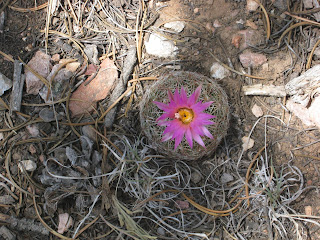Summer is here on Cedar Mountain. Hot and dry. Where was spring. Do we even have spring around here. It was only about a week ago that the morning low was 34 degrees. Now we are in that hot spell that always precedes our summer rains of July and August. Old-timers have told me "It has to get hot before it can rain." Actually there is some truth to this as the "heat low" that develops in the desert at this time of year is what draws the moisture in from the south to feed our summer rains. This is when the newly sprouted plants in our garden are really tested. These tender domesticated things want to just shrivel up and blow away in the hot, dry wind. The native plants know what to do. They are still maintaining themselves on what's left of the spring moisture in the soil. But they don't try to grow much. They are waiting. Some like the globemallow have done a little flowering but the hot and dry have told them to wait.
Here's one that has a couple of flowers but if you look close you can see dozens of buds ready to open (or not) if and when we get the summer rains.
There's a common late summer blooming wildflower that the local rancher's call tallow-weed that sprouts in the spring if we have good spring moisture. They will grow into June as long as the moisture holds up in the soil. Then they stop. Waiting for the summer rains. They can survive quite a few weeks of dry through June and into July. If the rains come anywhere near on schedule (first half of July) they will have mostly survived and will continue to grow and bloom. Otherwise, if the rains are late they start to die out. The later the rains the fewer the blooming tallow-weed. Here is how the tallow-weed look today baking in the hot June sun:
They can hang in like this for a long time once they have become established. We have not had any moisture in about 4 weeks and as long as the summer rains come in the next 2 weeks most of these plants will make it. But what would have happened if we had not gotten enough spring moisture to get them started? Well back in the late 90's and early 00's we had a terrible drought. We didn't have the right conditions for tallow-weed for many years. But as soon as those conditions returned out popped the tallow-weed in abundance. Filling all the open spaces in the pinyon-juniper woodland with a carpet of sulphur-yellow blooms.
Our climate here is all about uncertainty. Our native plants have adapted to it. We may not see them or not see their blooms every year but they have learned (or their genes have learned) what to do no matter what. Our common cactus species are particularly well-adapted. Take the pin-cushion cactus. A common small round cactus which sets its flower buds in the spring if we get good snow that hangs around into April. But the actual blooming doesn't occur until late June.
Above is a pincushion I caught blooming yesterday and to the right is a prickly pear that's been blooming for a few days now. It seems to have similar requirements as the pincushion and blooms about the same time. Both species are adapted to long drought periods where they may not bloom at all.
One of our local barberry species called aljerita has the same requirements for late spring snowmelt as the pincushion cactus. The aljerita is blooming like crazy right now. Here is recent picture:
What happens if we don't get our winter snow? If we have a dry winter, the aljerita, which normally sheds a few leaves prior to adding new growth in the spring, will drop all of its leaves. It looks dead. But when the rain finally comes, it resurrects itself. It has learned patience with our frustrating climate.
This is how you adapt to uncertainty. This is how you survive in the Southwest. You give something up one year or two years then you gain it back and then some in the good year. It's how we do it and coyotes do it and all opportunistic, adaptable species. As a last resort though, we can move. The plants are stuck and have learned to adapt to this extreme variability. I am in awe at this.





No comments:
Post a Comment